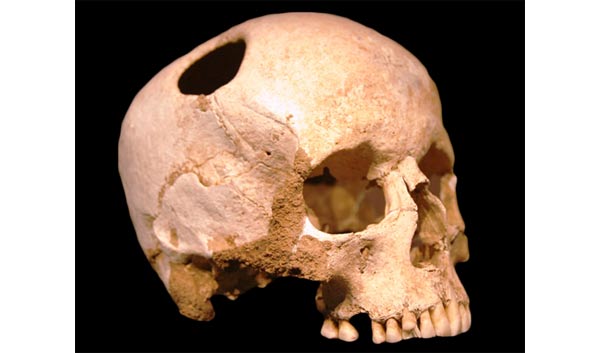Ancient Pazyryk nomads carried out highly advanced cranial surgery in Siberia
Russian neurosurgeons, anthropologists, and archaeologists are working together to reconstruct the way in which ancient nomads from the Pazyryk tribe in the Altai Mountains of Siberia managed to carry out extremely advanced cranial surgery 2,300 to 2,500 years ago. The techniques they used also bear a remarkable similarity to those found in the Hippocratic Corpus, a collection of ancient Greek medical texts written in the late 5 th century BC and early 4 th century BC, leading researchers to question the nature of interaction between the two cultures.
According to the Siberian Times, archaeologists discovered two ancient skulls that show clear evidence of recovery after undergoing a surgical procedure known as trepanation, which is one of the first ever surgical practices. It involves drilling or scraping a hole in the skull of a living person to cure illness such as convulsions, headaches, infections or fractures. Although there is some merit to the technique and it is still practiced today for the relief of subdural haematoma, it is a highly dangerous procedure.
"In the middle 19th century, the survival of patients after trepanation in the best hospitals in Europe rarely exceed 10%," the research team from the Institute of Archaeology and Ethnography of the Siberian Branch of Russian Academy of Sciences told the Siberian Times. "Even today, with advanced neurosurgical techniques, successful implementation of trepanation requires the serious knowledge and training."
Yet, 2500 years ago, two individuals in the Altai Mountains underwent the procedure and survived, as evidenced by later bone growth around the hole in the skull. Further examination of the features of the two skulls revealed that there was no luck involved in this surgery. Rather, it was carried out with phenomenal precision and with a highly advanced knowledge of physiology.
In one case, the skull of a middle-aged man showed that he had suffered from head trauma to his left temporal and parietal bones and developed a subdural haematoma, where blood collects between the skull and the surface of the brain. The Pazyryk surgeon made a small hole behind the cranial suture, at an appropriate distance from the edge of the sagittal sinus, a venous channel that drains blood from the brain into the internal jugular vein. The position of the hole reveals that the doctor clearly had a lot of knowledge about the structure of the brain and where to operate. Evidence of later bone growth revealed that the man went on to live for many years after the surgery.

Skull of middle-aged man with evidence of trepanation found in the Altai Mountains of Siberia. Credit: Institute of Archaeology – Will Stewart
The second skull was from a man with a congenital defect from birth, which the surgeon wanted to ameliorate. Again, the surgeon made a hole in the skull in a place where safety was maximised, avoiding damage to the joints and the membrane surrounding the brain.

Skull of second male with trepanation, who had a hereditary deformation of the skull. Credit: Institute of Archaeology – Will Stewart
"Pazyryk culture did not leave any written sources, and that is why it is hard to understand clearly the motives of making such complicated surgery and the methods which were used by doctors," the researchers said.
However, what is even more perplexing is the fact that the surgical work seems to be in exact accordance with what is written in the ancient Greek medical texts known as the Hippocratic Corpus. The Pazyryk people were known to ancient Greek historians, and first mentioned by Herodotus in the 5 th century BC, suggesting that there was contact between the cultures. This is also supported by traces of Greek pottery and artistic styles in Pazyryk burials. However, little is known about the contact between these two cultures.
Anthropologist Tatyana Chikisheva said: “It is still unclear: were these medical skills the result of a link between early nomads of Siberia with the medical centres of the ancient world? Or did the Pazyryks separately come to the same conclusions as prominent ancient doctors in Greece and the Middle East?”.
The researchers are now trying to reconstruct the exact way in which the ancient surgeons carried out the procedures, as well as the type of implements they used. Detailed testing of the skulls have revealed traces of bronze in the skull samples, which provides a clue as to the surgical implements that they used.
Featured image: A trepanated skull, Neolithic. The perimeter of the hole in the skull is rounded off by ingrowth of new bony tissue, indicating that the patient survived the operation. Image source: Wikipedia




















Comments
I'm with you John, it also talks about them being nomads and the last time i checked, that means that they traveled around, so couldn't then have encountered and learned from other people? Or, could these two people pictured have travelled to where this type of surgery was taking place, much like some people travel to a specialized children's hospital, cancer center, etc?
love, light and blessings
AB
It is amusing to hear these researchers speculate on this mysterious misplaced medical practice. Many African tribes of today know as much about modern medicine as any ancient people but they still have operations performed on them by Western doctors. Should someone dig up their remains in the future will they too scratch their head, (or heads) and wonder how such a primitive people have accomplished highly advanced medical procedures? It is very possible that a Greek Doctor was living and practicing in that community and made a good living at it too. Or, a Siberian had studied in Athens and set up shop back home.